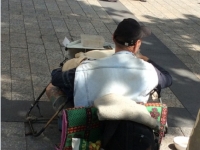Politics
THE POPULATION WHO EXPERIENCES HOMELESSNESS IS A HETEROGENEOUS GROUP.
IT CAN GO ON FOR WEEKS, MONTHS OR YEARS

(Source: © Ruby BIRD & Yasmina BEDDOU)
USPA NEWS -
When Homeless people hand out resume on a typed single sheet, instead of asking for handouts might be surprising. Most of the time, on it, we notice clearly what is proposed. First, the objective is declaired to become gain fully employed, get out of homelessness and ready for work now.
Even if he/she can add to work well under pressure troubleshooting, to love challenges and to meet deadlines with ease. It became a recurring action when thinking how to improve chances of getting a job. The reaction of people crossing such person is not anymore that is prank or a joke. Thousands of other people treat job search like a full-time job, being out from very early in the morning to sunset, for the entourage to notice how it is considered serious.
We can note, from the US Department of Health & Human Services, the following definition of the homelessness «The population who experiences homelessness is a heterogeneous group, and includes single individuals, families with children and unaccompanied runaways and homeless youth. While interventions to interrupt and end homelessness may vary accross groups, ending homelessness permanently requires housing combined whith the types of services supported by programs...»
They are defined three types of homelessness (www.hhs.gov). For the chronically homeless, it is due to their protracted spells of homelessness and the duration of their homeless history. Homeless famillies are defined as one or two adults accompanied by at least one minor child who are either not housed or who have had recent periods during which they lacked housing. At-risk individuals are defined by a number of other types of individuals who may be at-risk for becoming homeless or chronically homeless...
For example, homelessness among adolescents. Homeless youth are defined as persons between the ages of 16-24 who do not have familial support and are unaccompanied (living in shelters or on the street). Other vulnerable groups at-risk of homelessness include individuals with disabilities, immigrants, persons leaving institutions (eg. Incarceration, inpatient care for psychiatric or chronic medical conditions), youth aging out of foster care, frail elderly, persons experiencing abuse, and disaster victims.
Homeless Victim Youth Family Single Poverty Chronical Trouble Unemployment Job Recruitment Homelessness Plan Government Immigrant Disable Elder Frail Fragile Abuse Disadter Street Pain Housing Adolescent Child Girl Boy Minor
Liability for this article lies with the author, who also holds the copyright. Editorial content from USPA may be quoted on other websites as long as the quote comprises no more than 5% of the entire text, is marked as such and the source is named (via hyperlink).






